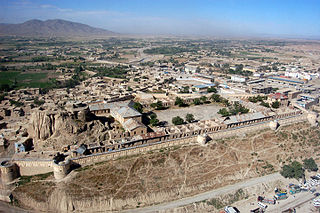
Gardez is the capital of the Paktia Province of Afghanistan. The population of the city was estimated to be ca. 10,000 in the 1979 census and was estimated to be 70,000 in 2008. The majority of the city's native population is Pashtun. The city of Gardez is located at the junction between two important roads that cut, through a huge alpine valley. Surrounded by the mountains and deserts of the Hindu Kush, which boil up from the valley floor to the north, east and west, it is the axis of commerce for a huge area of eastern Afghanistan and has been a strategic location for armies throughout the country's long history of conflict. Observation posts built by Alexander the Great are still crumbling on the hilltops just outside the city limits. The city of Gardez has a population of 70,641. It has 13 districts and a total land area of 6,174 hectares (23.84 sq mi). The total number of dwellings in this city is 7,849.


Paktika is one of the 34 provinces of Afghanistan, located in the eastern part of the country. Forming part of the larger Loya Paktia region, Paktika has a population of about 789,000, mostly ethnic Pashtuns. The town of Sharana serves as the provincial capital, while the most populous city is Urgun.
The Kharoti (Pashto:خروٹی) خروټی) are a Pashtun tribe of Ghilji origin, originating in the central part of Paktika Province, Afghanistan, but can be also found in other parts of the country. The Kharoti settled in Kharotabad in Quetta, British India around 1945.

Mata Khan District is a district of Paktika Province, Afghanistan. The district is within the heartland of the Andar tribe of Ghilji Pashtuns. The estimated population in 2019 was 26,720.


Mohammad Gulab Mangal is an Afghan politician. Since October 2016, he has been serving as the senior adviser minister of borders and tribal affairs for the president of the Islamic Republic of Afghanistan. He is also actively involved in the tribal conflict resolutions. On 23 October 2016, he was appointed as the senior adviser for the minister of borders, tribal affairs, and provincial governor of Nangarhar province until he resigned in April 2018. From 22 April 2015 to 23 October 2016, based on the presidential decree, he was appointed as the acting minister of Ministry of Borders and Tribal Affairs. In 2002, he was elected as the Representative of Paktia Province for Emergency Loya Jirga. From 2002 to 2004, he was the Head of Constitution office for the south east region(Paktia, Paktika, Khost and Ghazni provinces and also Head of Constitution Loya Jirga election office for the South East Region. From 2004 to 2006, he served as Governor of Paktika province. From 2006 to 2008, he served as the Governor of Laghman province. From March 2008 to September 2012, he served as provincial governor of Helmand province.
The Zadran, also spelled Dzadran or Jadran, jandran, is a Pashtun tribe that inhabits the Loya Paktia region in southeastern Afghanistan and parts of Waziristan in neighboring Pakistan. "Zadran: Pashtun tribe mainly residing in the “Zadran Arc” a 9-district area encompassing portions of the Khost, Paktya, and Paktika provinces."


Lōya Paktiā is a historical and cultural region of Afghanistan, comprising the modern Afghan provinces of Khost, Paktia, and Paktika, as well as parts of Logar and compromises Kurram and Waziristan of Khyber Pakhtunkhwa. Loya Paktia is vaguely defined by a common culture and history that is connected to the local indigenous tribes that reside in the region. Particular styles of clothing, articles of clothing, turban styles, turban cloth colors, dialects of Pashto language, etc. may sometimes be associated with specific tribes indigenous to Loya Paktia and thus integrate themselves into regional culture. For instance, a Pashtun tribesman from Loy Kandahar may quickly recognize a Pashtun from Loya Paktia based upon his turban style and color. Likewise, a Pashtun from Loya Paktia may recognize someone from Loy Kandahar based upon his unique style of collarless kameez (shirt) with specific embroidered patterns on the front. There are many subtle and intricate cultural indicators of this type that are not recorded in any known written history but simply known and observed by the tribesmen of the various Pashtun regions of Afghanistan and Pakistan.
Zarghun Shar or Zarghun Shahr may refer to:
2003 in Afghanistan. A list of notable incidents in Afghanistan during 2003
Urgun is the main town of the Urgun District of Paktika Province, Afghanistan. With an estimated population of 10,665, Urgun is the largest city of Paktika, while Urgun District, with a population of 89,718, is also the most populous district of the province. Urgun historically used to be the capital of Paktika, but in the 1970s, the capital was shifted from Urgun to Sharana in the west because Urgun was not easily accessible from the main Kabul–Kandahar Highway.
Janikhel District may refer to:

Mis Ainak Knights or Mis Ainak Region is one of eight regional first-class cricket teams in Afghanistan. The region represents the following provinces in the southeast of Afghanistan, to the south of the capital Kabul: Khost, Logar, Paktia and Paktika. The team is named after Mes Aynak, an archaeological site in Logar Province.
Sardeh Band or Sardeband is a town located on the eastern edge of Andar District, Ghazni Province, Afghanistan, near the border with Paktika Province. The town is located near the Sardeh Band Dam. The Sardeh Band Airport is located in the town.

Zēṛōk is the main town of Zerok District in Paktika Province, Afghanistan. It is located within the heart of Zadran land on the main Khost-Urgun road.
Firebases in the U.S.-Afghanistan War, are a type of military base, usually fire bases.








